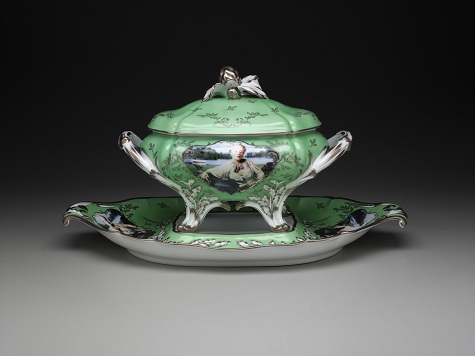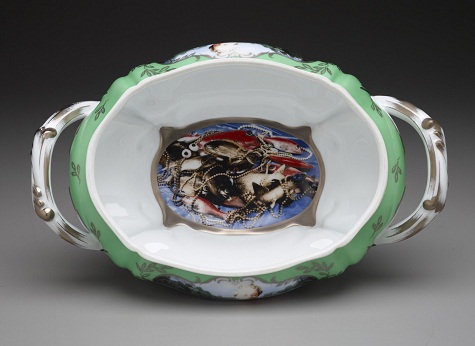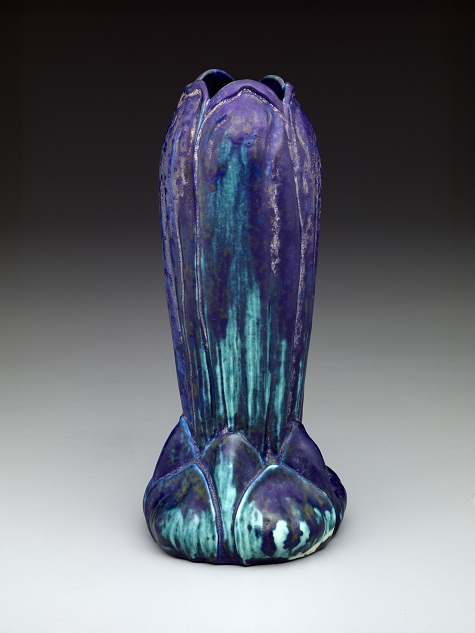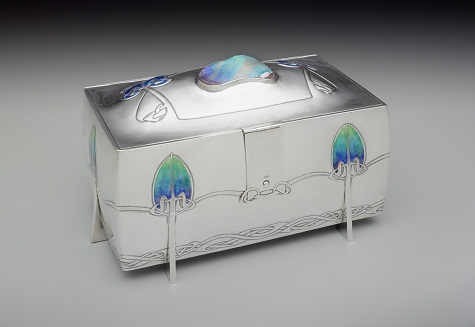In a museum the size of the DMA, it’s hard to keep track of isolated changes over 370,000 square feet. So we are letting you know about three recent additions to the permanent collection that are now on view. I encourage you to visit the Museum and go on a “scavenger hunt” to see how these works add an extra spark to the galleries—remember, general admission is free!
All three of the works fall within the purview of decorative arts and were originally marketed to elite consumers. One is by a well-known figure—the 19th-century design magnate Louis Comfort Tiffany (American, 1848-1933). Fans of contemporary art or those familiar with the DMA’s upcoming exhibitions will recognize the name of photographer Cindy Sherman (American, born 1954). The third designer may be unknown outside of specialist circles, but during his lifetime Archibald Knox (British, 1864-1933) was credited with developing a uniquely British approach to the Art Nouveau movement.

Cindy Sherman, “Madame de Pompadour (née Poisson)” soup tureen with platter, 1990, Ancienne Manufacture Royale de Francem, porcelain with silkscreen transfer and platinum decoration, Dallas Museum of Art, DMA-amfAR Benefit Auction Fund
From March 17 to June 9, the Cindy Sherman exhibition will adorn the walls of the Barrel Vault and Quadrant Galleries, but visitors to the European Galleries can also encounter the contemporary American’s work. Her Madame de Pompadour (née Poisson) soup tureen with platter sits camouflaged with rococo curves and floral embellishments. It creates a provocative disjuncture amid a wall of paintings by Canaletto (Italian, 1697-1768), Jean-Baptiste Oudry (French, 1686-1755), and Jacques-Louis David (French, 1748-1825).
Madame de Pompadour (French, 1721-1764) was the most famous of King Louis XV’s mistresses. She played a critical role in elevating rococo style to the pinnacle of aesthetic taste in mid-18th-century France. In 1756 she commissioned a tureen and platter from the renowned porcelain manufacturer in Limoges. Over two hundred years later, Sherman used the same factory to produce a limited-edition interpretation based on Pompadour’s original design.
Sherman takes on the guise of a historical tastemaker but allows viewers to be in on her joke. Close inspection of the photo-silkscreened portrait (reproduced twice on both the tureen and platter) reveals a pastiche—the theatrical make-up, somewhat ratty shawl, ill-fitting gray wig, and conspicuously faux breasts.

Cindy Sherman, “Madame de Pompadour (née Poisson)” soup tureen with platter, interior, 1990, Ancienne Manufacture Royale de Francem, porcelain with silkscreen transfer and platinum decoration, Dallas Museum of Art, DMA-amfAR Benefit Auction Fund
Museum guests won’t glimpse the tureen’s additional humorous detail because it is hidden on the base of the interior. As a visual pun on Pompadour’s maiden name and extreme wealth, Sherman created a still life of fish (French, poisson) and beaded necklaces.

Tiffany Studios, Vase, c. 1905-1919, earthenware, Dallas Museum of Art, Discretionary Decorative Arts Fund
Several new installations spice up the displays in the North Decorative Arts Gallery. Here you can find the latest addition to the DMA’s collection of works by Tiffany. Placed in a corner case surrounded by other examples of leading art pottery manufacturers, the brilliant hues of this small vase seem to reiterate the impact Tiffany Studios had on American decorative arts.
The iridescent surface shimmers with deep indigos, purples, and teals. The shape conjures images of flower petals or buds. Both traits demonstrate Tiffany’s dual focus on nature and mastering a material’s technical possibilities.
He coined the term “Favrile” in 1893 as an adaptation of the Old English word for “handmade.” The same moniker distinguished the wares of the ceramic workshop when it opened at Tiffany Furnaces (Corona, New York). As seen here, the glazing process allowed for creative expression and experimentation on the surface of an object formed from an existing mold.

Archibald Knox, Liberty and Co., W. H. Haseler & Co., Box (model 652 variant), 1905, Dallas Museum of Art, anonymous gift.
The third object making its DMA debut appears in a case on the east wall of this gallery. It’s hard to miss a lavish box decorated with incised linear patterns and blue-green enamel, and topped by a sizeable opal. On the adjacent platform, a charger with ship motif (1881) and a bench (1900) echo the Celtic stylings seen on Knox’s construction. Taken as a whole, the arrangement illustrates the late 19th-century interest in national identity. Many artists in Europe used the contemporary archeological discoveries of Scandinavian sites as source material for a “Viking Revival” style.
This piece is one of four variants known to exist. Unlike the other, simpler iterations, the model 652 variant features a bulging lid beset with a substantial gem. Within Liberty & Co.’s Cymric line, this would have been one of the costliest items for sale. Thankfully, this and the other works described above can be seen free of charge at the Dallas Museum of Art.
Emily Schiller is the McDermott Graduate Curatorial Intern at the Dallas Museum of Art.